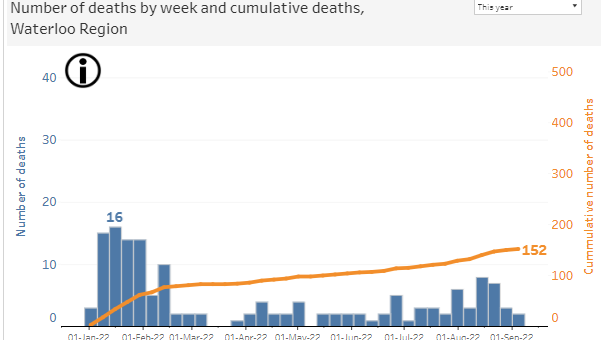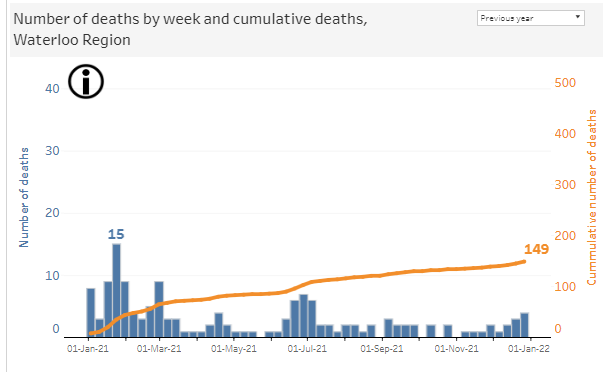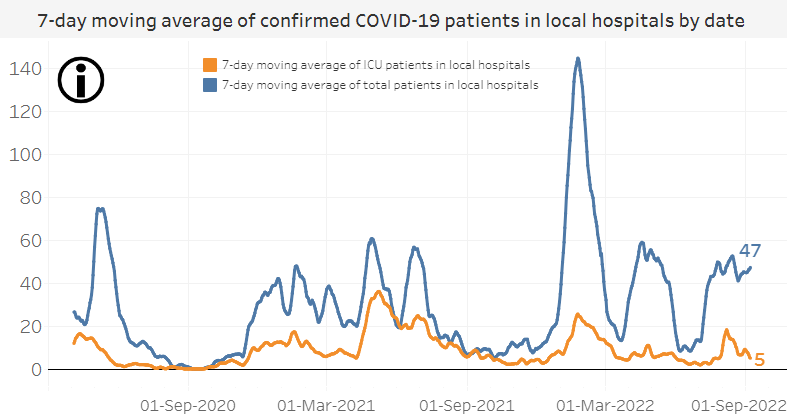More COVID-19-related deaths so far in 2022 than all of 2021
There have been more COVID-19-related deaths in Waterloo region so far in 2022 than there were in all of 2021, according to the Region of Waterloo’s COVID-19 dashboard.
The region’s update on Sept. 9 recorded 10 new deaths, bringing the total so far this year to 152. According to Waterloo Region Public Health, in 2021 there was a total of 150 COVID-19-related deaths.
“I think people may find that surprising because they’re not hearing as much about COVID these days, and also the numbers don’t seem to be that high,” said Dr. Hsiu-Li Wang, Region of Waterloo medical officer of health. “But, you have to understand, since the Omicron era, the testing has also gone from being available to the population broadly to really being only focused on those at highest risk.”
COVID-19 data from public health shows from Jan. 1 to Sept. 9 in 2021 there were 123 deaths, meaning the same time frame in 2022 saw 29 more.
 The number of COVID-19 related deaths in 2022. (Region of Waterloo Pubic Health)
The number of COVID-19 related deaths in 2022. (Region of Waterloo Pubic Health)
“This is really a reflection of the much greater spread of COVID-19 since the Omicron era. There have been many more infections of COVID-19 since Omicron, and even though our overall population immunity has improved from vaccine and infections that have occurred, there’s always going to be a percentage that results in serious outcomes and death,” said Wang.
The dashboard shows the start of 2022 had a high weekly COVID-19 death rate, with a number of weeks in January reporting double-digit COVID-19-related deaths.
There were 16 deaths reported during the week of Jan. 16, 2022, making it the deadliest week that year. The week on Jan. 24 had the highest number of deaths in 2021 with 15.
The dashboard shows that in the third quarter of 2021, the number of COVID-19-related deaths stayed relatively low with weekly updates typically reporting two deaths per week, with multiple weeks reporting zero deaths. During the same time in 2022, the dashboard shows three or more deaths typically were reported per week, with some weeks seeing as high as eight deaths.
 The number of COVID-19 related deaths in 2021. (Region of Waterloo Pubic Health)
The number of COVID-19 related deaths in 2021. (Region of Waterloo Pubic Health)
“When you have that many infections you’re still going to have a proportion that are serious and that’s why, unfortunately, we see a number of deaths still that are either caused by or in which Omicron had a contribution to the death,” said Wang.
The region reports a COVID-19-related death if a variant, such as Omicron, contributed to the death as a primary or secondary cause.
Wang said the experts are predicting that this fall and winter season we can expect greater circulation of COVID-19 again.
To date, the Region of Waterloo has recorded 470 deaths since the beginning of the pandemic linked to COVID-19.
 This graph shows the number of people hospitalized with COVID-19 in Waterloo region from April 2020 to Sept. 7. (Region of Waterloo)
This graph shows the number of people hospitalized with COVID-19 in Waterloo region from April 2020 to Sept. 7. (Region of Waterloo)
INFECTIOUS DISEASES SPECIALIST WEIGHS IN
“I think we have realized that we have to wait for the annual counts of mortality, that means we have to wait a few more months and see whether the trend holds,” said Zahid Butt, infectious disease epidemiologist at the University of Waterloo.
“The main thing is the trend, whether you are seeing these excess deaths due to COVID-19, and there has been some debate before on excess deaths reporting from most of the provinces in Canada.”
Butt said it is important to dig deeper past the raw data to understand how these deaths were linked to COVID-19, and if they were incidental – such as when patients come to the hospital and test positive for COVID-19.
“We’ll have to keep that in mind looking at really digging deep and looking at whether these deaths are directly related to COVID-19, and then also trying to figure out if they’re indirectly related to COVID-19,” said Butt.
Butt said the COVID-19 deaths could be from an effect like cancelled surgeries, delayed diagnostics, delayed testing of certain conditions and low access to healthcare. He said this trend was visible in 2021.
“You could see that event happening in 2021, and then that trickles down to 2022,” said Butt.
CTVNews.ca Top Stories

Half of Canadians have negative opinion of latest Liberal budget: poll
A new poll suggests the Liberals have not won over voters with their latest budget, though there is broad support for their plan to build millions of homes.
opinion Why you should protect your investments by naming a trusted contact person
Appointing a trusted person to help with financial obligations can give you peace of mind. In his personal finance column for CTVNews.ca, Christopher Liew outlines the key benefits of naming a confidant to take over your financial responsibilities, if the need ever arises.
Twins from Toronto were Canada's top two female finishers at this year's Boston Marathon
When identical twin sisters Kim and Michelle Krezonoski were invited to compete against some of the world’s most elite female runners at last week’s Boston Marathon, they were in disbelief.
Ottawa injects another $36M into vaccine injury compensation fund
The federal government has added $36.4 million to a program designed to support people who have been seriously injured or killed by vaccines since the end of 2020.
Senate expenses climbed to $7.2 million in 2023, up nearly 30%
Senators in Canada claimed $7.2 million in expenses in 2023, a nearly 30 per cent increase over the previous year.
NASA hears from Voyager 1, the most distant spacecraft from Earth, after months of quiet
NASA has finally heard back from Voyager 1 again in a way that makes sense. The most distant spacecraft from Earth hadn't sent home any understandable data since last November.
U.S. Senate passes bill forcing TikTok's parent company to sell or face ban, sends to Biden for signature
The Senate passed legislation Tuesday that would force TikTok's China-based parent company to sell the social media platform under the threat of a ban, a contentious move by U.S. lawmakers that's expected to face legal challenges.
Train derailed in Sarnia after colliding with a truck
Police are investigating after a transport truck collided with a train in Sarnia.
Photographer alleges he was forced to watch Megan Thee Stallion have sex and was unfairly fired
A photographer who worked for Megan Thee Stallion said in a lawsuit filed Tuesday that he was forced to watch her have sex, was unfairly fired soon after and was abused as her employee.
































